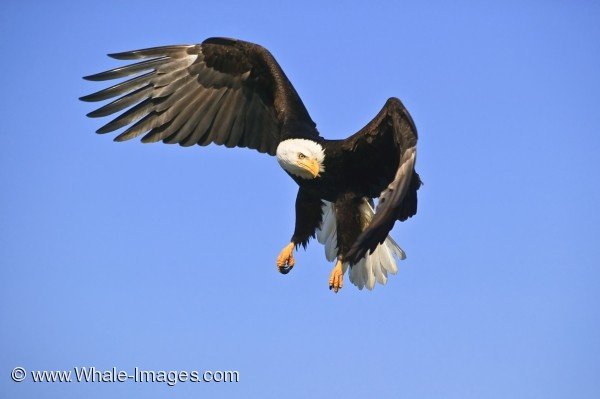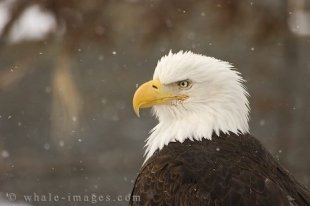Bald Eagle Facts Information
Facts, information and pictures for Bald Eagle birds.
Path: Animal Facts / Bald Eagle Facts & Information
Bald Eagle bird - Haliaeetus leucocephalus
- Scientific name: Haliaeetus leucocephalus
- Class: Aves (Birds)
- Family: Accipitridae
General Bald Eagle Information
The majestic Bald Eagle (here are our bald eagle pictures) is a large and powerful bird of prey. The scientific name, Haliaeetus, means “sea eagle” and leucocephalus translates as “white head.” Though the eagle’s white head may look bald to some, the word “bald” actually comes from the old English word for white.
There are 59 species of Eagles in the world, but the Bald Eagle and Golden Eagle are the only eagles found in North America. The Bald Eagle does not occur outside of North America.
The Bald Eagle has been the national symbol of the United States since 1782. Due to habitat loss and pollutants, eagle populations declined dramatically in the 20th century. Conservation efforts over the past 40 years have had a positive effect, and Bald Eagle populations are much stronger than they once were in many areas.
Identification Features
Adults are easy to identify, with a very dark brown body and a striking white head and tail. The beak, legs, feet and eyes are yellow. Males and females have identical plumages, but juveniles are mostly brown, with some white mottling beneath the wings. It takes four to five years, during which time juveniles go through a series of variable plumages, before they look like adults.
Juvenile Bald Eagles are sometimes mistaken for other birds, such as Turkey Vultures or Golden Eagles.
Bald Eagles are huge birds, and females are a bit larger than males. They stand around 76 cm tall, and weigh about 7 kg. Eagles typically soar on long, straight-edged wings that often span more than two metres.
Characteristics
Bald Eagles have remarkable eyesight, which enables them to spot prey (alive or dead) at great distances. They can see three to four times farther than humans. The senses of taste and smell are not very well developed, and hearing ability is similar to that of humans.
To kill and grasp their prey, eagles are equipped with a large beak and razor sharp talons. The bottoms of the feet have small spikes called spicules, which help them hold onto fish.
Eagles have a screaming call that is broken into a series of stuttering notes which can carry their voices over long distances.
Bald Eagles can live up to 35 years in the wild, and even longer in captivity.
Range and Habitat
Bald Eagles live along the edges of oceans and lakes, where large trees can be found that are suitable for perching and nesting. If they can find enough food, they may stay in one location year round. Some eagles migrate south in the winter, or from an inland lake to the ocean, to find a wintering area with a good food source.
Bald Eagles are found throughout most of North America in Canada, the United States and northern Mexico. The largest populations are concentrated along the Pacific Coast, and Bald Eagles are especially abundant in British Columbia and Alaska.
Diet
Eagles are large predators, and use a combination of scavenging and hunting to secure their food supply. Adults are more likely to kill live prey, whereas juveniles rely mostly on scavenging and piracy (snatching food from other birds.)
Bald Eagles primarily eat fish, but also feed on sea birds and mammals. When hunting, eagles will often target sickly or wounded individuals. Eagles also scavenge for carrion, and feed upon road-kill, or dead fish. Rivers with salmon that have died after spawning attract high number of eagles. A hungry eagle will eat almost anything, and eagles will not hesitate to steal a meal from other birds.
Courtship and Breeding
Bald Eagle courtship is elaborate and dramatic, with special aerial acrobatics. A pair will lock talons and cartwheel through the air, or swoop and chase each other. Eagles often mate for life, but if one partner dies, they will find a new mate. Repeated failure to breed may cause eagles to split up and seek new partners.
Eagles choose the largest and tallest tree they can find near fresh or salt water to build their nests. The nests, called aeries, are often positioned near the top of the tree. Eagles defend a territory around the nest (one or two kilometers) from other eagles. Old growth forest stands provide the best nesting trees, but eagles will also nest on cliffs, if trees are not available. Eagles often return to the same nest site year after, and will keep mending the nest with new sticks and vegetation.
Bald Eagles have the largest nest of any North American bird. The nest is up to two metres wide and about one metre tall. The largest nest on record was three metres wide and six metres high, and weighed more than two tons. The nest is made up of branches and twigs that are woven together. A small depression in the center is lined with soft vegetation and feathers.
Females lay one-three eggs, two to four days apart. During the incubation period, which is around 35 days, the female sits on the nest continuously to keep the eggs warm and protect them from predators. The eggs hatch two or three days apart and the baby eaglets are covered in grey down. In four to five weeks they begin to grow feathers.
Females, and sometimes males, brood the young and parents may take turns bringing food to the nest. The largest eaglet eats first, and the smallest sibling may starve or be killed by the larger one. Eaglets have huge appetites and grow rapidly. Eventually, they are able to feed themselves and are ready to fledge from the nest at around 78 days.
Mortality of juveniles is high, and less than 50% will survive to adulthood.
Conservation
Populations of Bald Eagles began to decline when European settlers moved westward in the late 1800’s. Habitat loss, such as logging the forests, negatively affected Eagles’ breeding areas and feeding grounds. Eagles were also frequently shot for sport. In 1940 the Bald Eagle Act prohibited the killing of Bald Eagles in the lower 48 states. Despite this, populations continued to decline.
By the late 1940’s it was discovered that high concentrations of DDT, a pesticide commonly sprayed along the coast to kill mosquitoes, was harming the eagles’ reproduction. Being at the top of the food chain, Bald Eagles absorbed much more DDT than smaller organisms. The high level of DDT affected female birds’ ability to absorb calcium, resulting in eggshells that were too thin. Heavy restriction of the use of DDT has resulted in a comeback for eagles in many areas.
Today, Bald Eagles are quite common in western Canada and Alaska, but they continue to be endangered in some of the Eastern Canadian provinces and parts of the lower 48 states of the United States. Bald Eagles are still threatened by pollution, habitat loss, and other human-caused hazards, but strong conservation efforts have also boosted eagle populations significantly. There is hope that these iconic birds will be around for many generations to come.
Some bald eagle pictures:
Keywords
- page
- Animal Facts (9)







